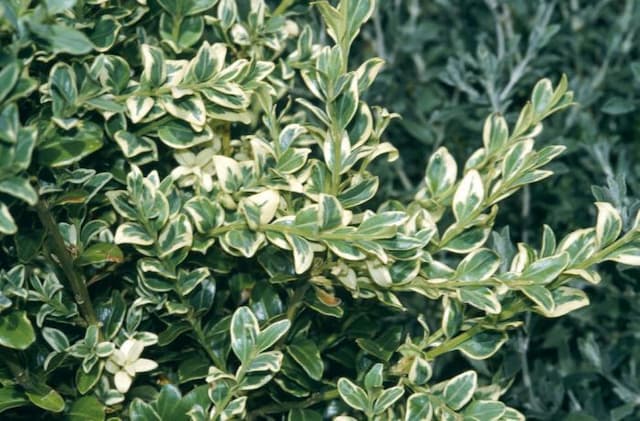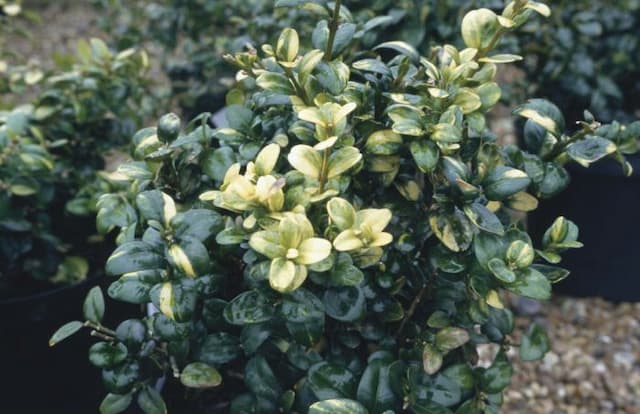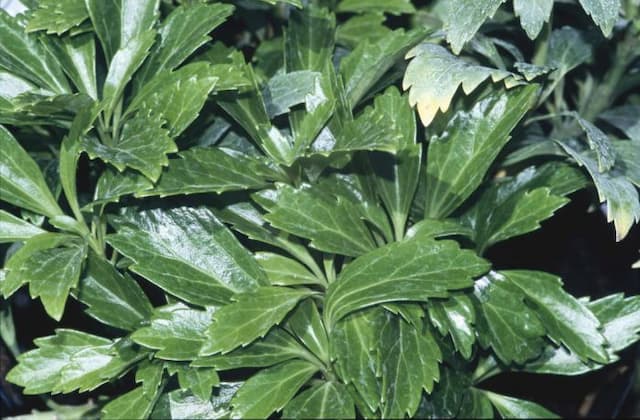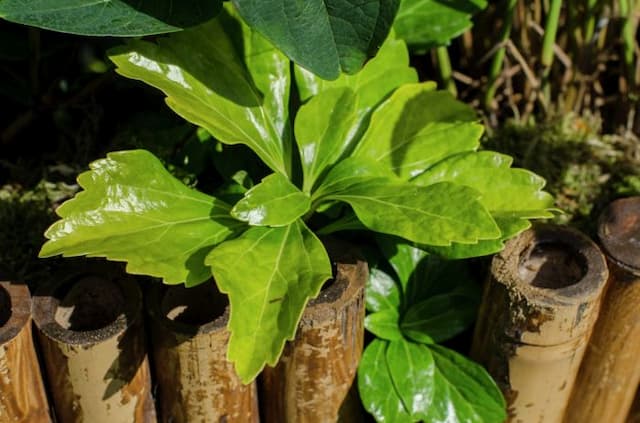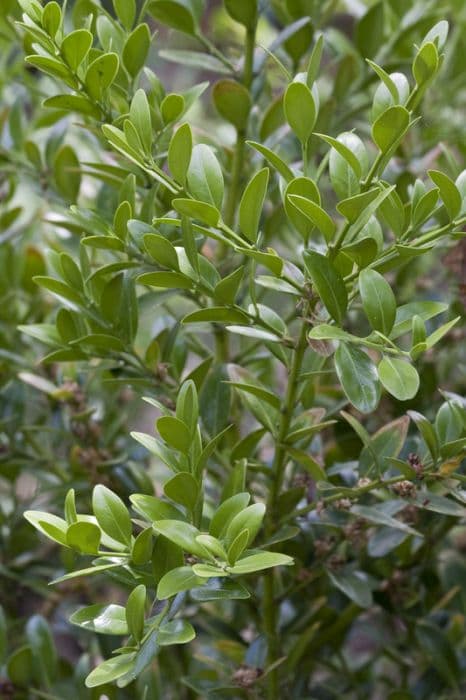Sweet Box Sarcococca hookeriana var. digyna 'Tony Schilling'

ABOUT
Sweet box, specifically the 'Tony Schilling' variety, is an evergreen shrub with a dense, bushy habit. Its leaves are dark green, leathery, and glossy, adding a touch of elegance to the plant's overall appearance. The foliage is arranged in an alternating pattern along the stems, which adds to the textural interest of the shrub. During the late winter to early spring, sweet box produces small, sweetly fragrant flowers. These flowers are typically white or pale pink and are somewhat inconspicuous against the dark foliage. However, they are highly valued for their delightful scent which can catch you by surprise when walking past the plant. Following the flowering period, sweet box may produce blackberry-like fruits. These berries can add visual interest to the plant, although they are not edible. The overall appearance of sweet box is one of lushness and vitality, making it a favoured choice for gardeners looking to add reliable structure and year-round interest to their gardens. Its compact growth and attractive features make it suitable for a variety of uses, from foundation plantings to borders and woodland gardens.
About this plant
 Names
NamesFamily
Buxaceae.
Synonyms
Sweet Box, Christmas Box, Fragrant Sarcococca.
Common names
Sarcococca hookeriana var. digyna 'Purple Stem', Sarcococca ruscifolia var. chinensis.
 Toxicity
ToxicityTo humans
Sweet Box is not commonly considered toxic to humans. However, like many plants, it could potentially cause mild stomach upset if ingested. There are no severe toxicity symptoms commonly associated with this plant for humans.
To pets
Sweet Box is also not commonly considered toxic to pets. While it should not be a problem if pets come into contact with this plant, ingestion of plant parts could potentially result in mild gastrointestinal upset in some animals, similar to how they might react to other non-toxic plants they aren't used to eating. There are no severe toxicity symptoms commonly associated with this plant for pets.
 Characteristics
CharacteristicsLife cycle
Perennials
Foliage type
Evergreen
Color of leaves
Green
Flower color
White
Height
3-5 feet (0.91-1.52 meters)
Spread
3-5 feet (0.91-1.52 meters)
Plant type
Shrub
Hardiness zones
6
Native area
Himalayas
Benefits
 General Benefits
General Benefits- Evergreen Foliage: Provides year-round greenery and structure to gardens even in winter months.
- Low Maintenance: Requires minimal care once established, making it ideal for busy or novice gardeners.
- Shade Tolerance: Grows well in shaded areas where other plants may struggle to thrive.
- Fragrant Flowers: Tiny white blooms in late winter or early spring emit a pleasant fragrance, adding sensory appeal to the garden.
- Drought Tolerance: Once established, it can tolerate periods of dryness, reducing the need for frequent watering.
- Pest and Disease Resistance: Generally resistant to common garden pests and diseases, thus reducing the need for chemical treatments.
- Dense Growth Habit: Can be used as a ground cover or for filling in gaps, providing a lush underplanting in landscape designs.
- Wildlife Friendly: Provides shelter and food for birds and beneficial insects, enhancing local biodiversity.
- Suitable for Containers: Can be grown in pots or planters, making it versatile for patios, balconies, or small spaces.
- Decorative Berries: Produces attractive black berries in the fall that can add visual interest to the garden.
 Medical Properties
Medical PropertiesThis plant is not used for medical purposes.
 Air-purifying Qualities
Air-purifying QualitiesThis plant is not specifically known for air purifying qualities.
 Other Uses
Other Uses- Sweet Box branches can be used in flower arrangements, where their dense foliage and small, fragrant flowers provide a delicate filler for bouquets.
- The wood of Sweet Box, being hard and dense, may be used in small-scale woodworking projects for crafting decorative items or tool handles.
- During winter, the evergreen leaves of Sweet Box can serve as a robust, green backdrop in otherwise dormant gardens.
- Sweet Box can be planted as a form of erosion control on slopes due to its spreading, rooting habit that helps maintain soil integrity.
- The aromatic qualities of Sweet Box flowers make them a subtle, natural option for imparting fragrance in drawers or closets when dried.
- As a densely growing shrub, Sweet Box can be utilized for creating low-lying, living garden borders or pathways.
- Sweet Box's tolerance for shade makes it an ideal under-planting for larger shrubs and trees, filling in gaps with its lush foliage.
- In regions where it's hardy, Sweet Box can be planted in containers and used to adorn patios or balconies, adding greenery to urban spaces.
- The plant can function as an outdoor privacy screen when planted in a continuous row or hedge form due to its dense growing nature.
- In some cultures, Sweet Box may be used in festive decorations, particularly around Christmas, because of its evergreen leaves and winter bloom time.
Interesting Facts
 Feng Shui
Feng ShuiThe Sweet Box is not used in Feng Shui practice.
 Zodiac Sign Compitability
Zodiac Sign CompitabilityThe Sweet Box is not used in astrology practice.
 Plant Symbolism
Plant Symbolism- Protection: Sarcococca, also known as Sweet Box or Christmas Box, is often associated with protection due to its dense, evergreen foliage that creates a sheltering presence in gardens year-round.
- Purity: The clean, white flowers of the Sweet Box, which bloom even in the winter months, symbolize purity and the ability to thrive even in adversity.
- Perseverance: Sweet Box's ability to flower in the cold winter season represents perseverance and the idea of overcoming challenges regardless of circumstances.
 Water
WaterSweet Box should be watered regularly to maintain consistent soil moisture, especially during the first growing season to establish a deep root system. Depending on climate and soil conditions, this can translate to about 1 inch of water per week, whether from rainfall or manual watering. During dry spells, increase watering to twice a week, ensuring that the water penetrates deeply into the soil rather than just wetting the surface. Avoid overwatering, as Sarcococca appreciates well-draining soil and does not like to sit in waterlogged soil. Reduce watering frequency in the winter when the plant is dormant and evaporation rates are lower.
 Light
LightSweet Box thrives best in partial to full shade, making it ideal for planting under the canopy of larger trees or in the shadowed areas of buildings. It can tolerate some morning sunlight but should be protected from the harsh afternoon sun to prevent leaf scorch. A north-facing spot that receives filtered light is excellent for promoting its lush, evergreen foliage and fragrant blooms.
 Temperature
TemperatureSweet Box is hardy and can tolerate a range of temperatures, ideally flourishing in conditions between 60°F and 80°F, but it can survive winter temperatures down to about 0°F. It appreciates shelter from harsh cold winds and extreme heat. The plant is more comfortable in cooler climates that mimic its native woodland habitats.
 Pruning
PruningSweet Box should be pruned to maintain shape and encourage denser foliage. The best time to prune is in late winter or early spring, before new growth begins. It doesn't require heavy pruning—simply remove any dead or damaged branches and trim back any wayward growth to keep the plant tidy. This is also an opportunity to cut back older stems to stimulate new growth, which can be done every few years.
 Cleaning
CleaningAs needed
 Soil
SoilSweet Box requires well-draining, rich organic soil with a pH between 5.5 and 6.5. A mix of loam, peat, and sand can provide good drainage and nutrient retention.
 Repotting
RepottingSweet Box typically does not require frequent repotting; it can be repotted every 2-3 years or when it outgrows its current container.
 Humidity & Misting
Humidity & MistingSweet Box thrives in moderate to high humidity levels but is quite adaptable and can tolerate lower humidity indoors.
 Suitable locations
Suitable locationsIndoor
Provide filtered light, keep soil moist, and maintain high humidity.
Outdoor
Plant in partial shade, shelter from strong winds, and ensure well-draining soil.
Hardiness zone
6-9 USDA
 Life cycle
Life cycleThe Sweet Box (Sarcococca hookeriana var. digyna 'Tony Schilling') starts its life as a seed that germinates in moist, well-drained soil, preferably in partial to full shade. The seedling then develops into a young plant with glossy evergreen leaves and establishes a root system. As it matures, the plant exhibits slow to moderate growth, forming an evergreen shrub that typically reaches up to 5 feet in height and spread. During late winter to early spring, the Sweet Box produces small, fragrant, creamy-white flowers, which are followed by black berries if pollinated. Once the flowers are pollinated, the berries ripen and may eventually fall to the ground, where they can self-seed, starting the cycle anew. Over the years, this plant requires minimal maintenance, preferring cool roots and heads in the sun or shade, and can live for many years in the right conditions.
 Propogation
PropogationPropogation time
Early Spring
The most popular method of propagation for Sweet Box, specifically the Sarcococca hookeriana var. digyna 'Tony Schilling', is via semi-ripe cuttings. This process typically begins in late summer to early fall. To propagate Sweet Box, one would cut a 4 to 6 inch (about 10 to 15 cm) section of semi-ripe stem from the current year's growth, ensuring that a few leaves are present. The lower leaves should be removed, and the cutting can be dipped in rooting hormone to encourage root growth. The prepared cutting should then be inserted into a pot filled with a mix of peat and perlite. Place the pot in a warm, humid environment, such as a greenhouse or under a plastic cover, and ensure the soil remains moist but not waterlogged. Roots generally develop over several weeks, after which the new Sweet Box plants can be transplanted.
